
Sonic Heroes is a 2003 platform game developed by Sonic Team USA and published by Sega as part of the Sonic the Hedgehog series. The player races a team of series characters through levels to amass rings, defeat robots, and collect the seven Chaos Emeralds needed to defeat Doctor Eggman. Within each level, the player switches between the team's three characters, who each have unique abilities, to overcome obstacles. Sonic Heroes downplays the action-adventure and exploration-based gameplay of its predecessors Sonic Adventure (1998) and Sonic Adventure 2 (2001) in favor of returning to the linear style of Sega Genesis-era Sonic games.
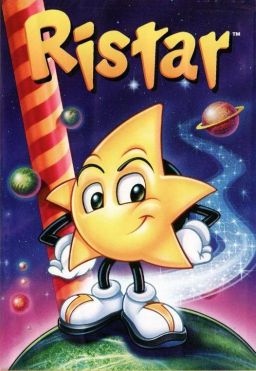
Ristar is a 1995 platform game developed and published by Sega for the Sega Genesis. The game stars an anthropomorphic cartoon star who uses his hands and long, stretchable arms to both move and fight enemies. Reception for the game was generally positive, but the game's initial release was overshadowed due to the imminent ending of the Genesis's lifecycle and the succession of the Sega Saturn and other fifth generation video game consoles.

Comix Zone (コミックスゾーン) is a 1995 beat 'em up video game developed and published by Sega for the Genesis. It is set within the panels of a comic book with dialogue rendered within talk bubbles and sprites, and backgrounds possessing the bright colors and dynamic drawing style of superhero comics. This style is in previous video games, for example Ocean Software's Batman: The Caped Crusader in 1988, but Comix Zone stretched the idea to such an extent that Sega applied for and was granted a patent for a "videogame system for creating a simulated comic book game".

Dynamite Headdy is a platform video game developed by Treasure and published by Sega for the Sega Genesis in 1994. The game follows a puppet named Headdy in his efforts to stop an evil puppet king from taking over his world. Headdy can throw his head at enemies to defeat them and use it to pull himself to various areas and move objects. The player can find a wide variety of "heads" which act as power-ups that provide different effects and alter gameplay.

Gunstar Heroes is a run and gun video game developed by Treasure and published by Sega. It was Treasure's debut game, originally released for the Sega Genesis in 1993. The game's premise is centered around a pair of characters, the Gunstars, in their efforts to stop an evil empire from recovering four powerful gems. The characters can fire guns and perform a series of acrobatic maneuvers to fight enemies across each stage. There are four weapons in the game which can be combined with one another to create different shot types.

Krusty's Fun House is a puzzle video game based on the animated sitcom The Simpsons.
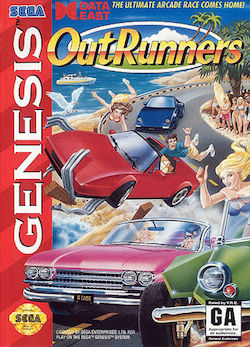
OutRunners is a 1993 racing video game developed by Sega AM1 on System 32 Multi hardware. It constitutes the third release in the arcade Out Run series, after Turbo OutRun (1989), and was ported to the Sega Genesis home console in 1994.

SegaSonic the Hedgehog is a 1993 arcade game in the Sonic the Hedgehog series by Sega. Controlling Sonic the Hedgehog and his friends Mighty the Armadillo and Ray the Flying Squirrel, the player must escape an island after they are kidnapped by the villain, Doctor Eggman. The game uses an isometric perspective. Players use a trackball to move the characters while dodging obstacles and collecting rings. The game was developed by Sega's arcade division, Sega AM3. It is one of four Sonic games with the SegaSonic name and was inspired by the 1984 game Marble Madness.

Sonic the Hedgehog 2 is a 1992 platform game developed by Aspect and published by Sega for the Master System and Game Gear. It is the sequel to the 8-bit Sonic the Hedgehog (1991) and follows Sonic as he attempts to get the Chaos Emeralds back to rescue his friend Miles "Tails" Prower from Dr. Robotnik. Like the first Sonic the Hedgehog, players run through levels at high speeds while collecting rings and defeating enemies. Although it shares the same title with Sonic the Hedgehog 2 for the Sega Genesis and their releases coincided, the games have little in common and share no levels.
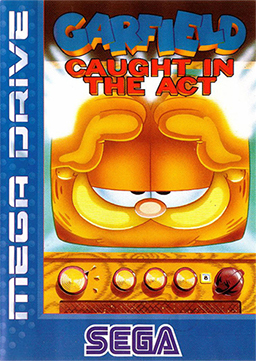
Garfield: Caught in the Act is a 1995 side-scrolling platform game developed and published by Sega for the Genesis and Game Gear. A Microsoft Windows version followed. It is based upon Jim Davis' comic strip cat, Garfield, and draws inspiration from Davis' 1984 book Garfield: His 9 Lives. Odie scares Garfield while they are watching television and they fall on the TV, breaking it. Both characters attempt to repair it before Jon Arbuckle catches them; however, the thrown spare parts become an electronic monster known as the Glitch, transporting Garfield into the TV, where he must defeat him in order to get out.

Mega Man: The Wily Wars is a 1994 video game compilation developed by Minakuchi Engineering and published by Capcom for the Sega Genesis; the compilation features remakes of the first three Mega Man games, alongside a new game called Wily Tower, only unlockable with a completed save file.
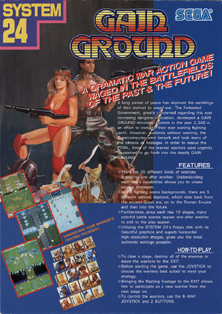
Gain Ground is an action game with strategy elements released as an arcade video game by Sega in 1988. It was ported to the Master System, Mega Drive/Genesis, and TurboGrafx-CD.

Ayrton Senna's Super Monaco GP II is an arcade-style Formula One racing video game developed and manufactured by Sega for the Sega Genesis, Master System, and the Game Gear in 1992. It is a follow-up to Super Monaco GP. The game was also endorsed by, and had technical input from, the then-Formula One champion Ayrton Senna. Gameplay includes a World Championship season featuring recreations of the tracks in the 1991 Formula One World Championship, along with a three-race "Senna GP" mode set on fictional tracks.
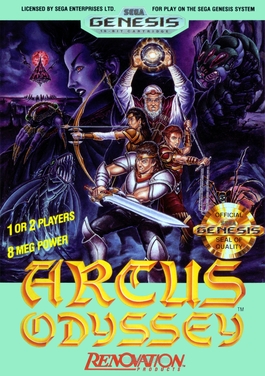
Arcus Odyssey is a 1991 action game developed by Wolf Team and released by Renovation Products for the Sega Genesis and X68000 and in 1993 for the Super Nintendo Entertainment System. The game features an isometric perspective and cooperative gameplay, as well hack and slash gameplay. It tells the story of four heroes trying to thwart the return of an evil sorceress.

McDonald's Treasure Land Adventure is a 1993 platform game developed by Treasure and published by Sega for the Sega Genesis. Based on the McDonald's fast food restaurant chain, specifically its McDonaldland marketing campaign, players control Ronald McDonald in his efforts to retrieve the missing pieces of a map that lead to the location of a buried treasure from a group of villains. Ronald can defeat enemies by using a magic attack and can latch onto hooks with his scarf to reach higher platforms.
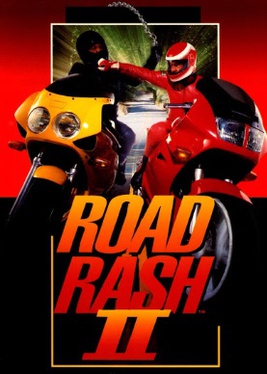
Road Rash II is a 1992 racing and vehicular combat game developed and published by Electronic Arts (EA) for the Sega Genesis. The game is centered around a series of motorcycle races throughout the United States that the player must win to advance to higher-difficulty races, while engaging in unarmed and armed combat to hinder the other racers. It is the second installment in the Road Rash series and introduces a split-screen two-player mode for competing human players, nitrous oxide charges on certain bikes, and chains as offensive weapons.

Spinmaster is an arcade game developed and released by Data East on December 16, 1993 in North America, in Europe the same year and on February 18, 1994 in Japan. It is the first game Data East developed and released for the SNK Neo-Geo MVS hardware. Its character designs are almost identical to the ones in Data East's Sega Genesis game titled Dashin' Desperadoes; however, the rest of both games are completely different. Also, Spinmaster's gameplay, artwork style, animations of some characters and the styles of its weapons were heavily inspired by another arcade game by Data East titled Joe & Mac, according to the Japanese Miracle Adventure arcade flyer.

Racing Hero is a 1989 arcade racing game from Sega which runs on the Sega X Board hardware. In Racing Hero, the player takes part in an international race aboard a motorcycle and races against time and other vehicles. It draws much inspiration from Sega's successful Hang-On and Out Run series.

Road Rash is a 1991 racing and vehicular combat video game originally developed and published by Electronic Arts (EA) for the Sega Genesis. It was subsequently ported to a variety of contemporary systems by differing companies. The game is centered around a series of motorcycle races throughout California that the player must win to advance to higher-difficulty races, while engaging in unarmed and armed combat to hinder the other racers.



















